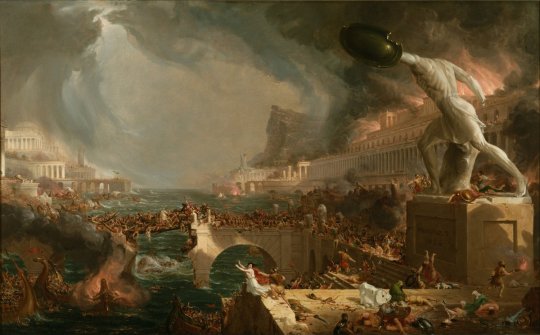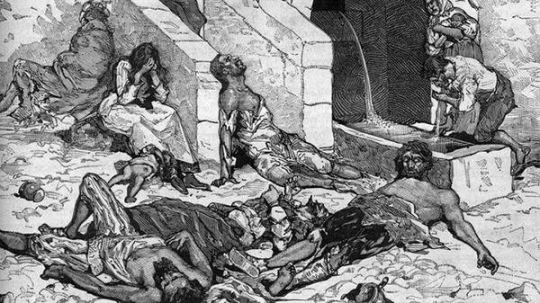#bubonic
Text
Medieval Medicine in a nutshell.
youtube
#medieval#medicine#meds#nutshell#plaguedoctor#plague doctor#plague#doctor#black death#black plague#bubonic#bubonic plague#animation#cartoon#Youtube
6 notes
·
View notes
Text
The Prequel Plague
The Black Death is synonymous with plague, but it wasn’t the first (or the last) epidemic of the bubonic plague. Think less Middle Ages and more about the Byzantine Empire. The first recorded instance of a plague epidemic was the plague of Justinian but it is lesser known.

“By which the whole human race came near to be annihilated” Procopius, the Byzantine court historian declared as he talked of the plague of Justinian in his book Polemon, or ‘Wars. The first wave of the plague ravaged the empire and Constantinople from 542-543 AC. The plague’s sporadic appearances would continue until 750 AC concreting it as the first- but certainly not the last- bubonic plague pandemic.
The word pandemic is Greek in origin, ‘pan’ meaning all and ‘demos’ meaning people. It was no surprise that as the plague engulfed the Byzantium the mortality rates soared, landing anywhere from 60-80% in some cases. Though the plague started in Egypt some time in 541 AC; Constantinople recorded approximately 300k deaths within the first year of the infection not more than a year later. The death toll rising by 5k to 10k a day during the 4 months it claimed Constantinople.
It was likely the disease was introduced through the port of Alexandria and from there it spread like wildfire. Even Procopius understood the grave nature at which the disease had spread:
“It began with the Egyptians who live in Pelusium. It divided and part went to Alexandria and the rest of Egypt, and part to the people of Palestine, the neighbors of the Egyptians, and from there overran the whole earth.”.
It’s no surprise that these words sound familiar in the 21st century. The shear speed in which the disease spread seems like a familiar memory in the wake of the 2019 Covid-19 pandemic. It’s difficult to know exactly the scale of the casualties as there is limited resources describing the populations at the time, this is what makes it largely more difficult to navigate in comparison to its successor: The Black Death. To add salt to the wound there is no clear documented evidence of the disease from a medical standpoint. Procopius of Caesarea was a high-ranking official under the reign of Justinian, living within the city of Constantinople at ground zero and John of Ephesus was a Christian bishop living within Syria at the time- both of whom had no medical experience. What can be said is regardless of dispute over the disease itself; they were both talking about the same plague.
Flicking through the sources and research notes it’s clear that most of what is known is a patchwork of information sewn together which leaves a large area for myths, doubts and discrepancies to arise. For the Justinian plague it seems far more common due to the scarcity of resources and so the plague seems to fly under the radar as the unknown prequel to the great mortality.

It’s important to start with the basics- to walk before you run. The ruler of the empire: Justinian ruled the Byzantine empire for 45 years from 527-65 AC. During this time, he made it a firm aspiration to reclaim territory in the wake of the Old Roman Empire’s dream- which was a fairly common goal amongst other rulers of Byzantium. The emperor was particularly keen in removing the remaining pagan roots from the empire and cutting out the corruption like an overdue tumor. He wasn’t particularly popular within his court. His closest advisors, due to his impoverished beginnings, were from outside the typical aristocratic class. Justinian was particularly authoritarian and believed that the emperor’s word was law- his ambitions, as most do, fell short.
As the wave of pestilence covered much of the empire, not even the emperor was spared. The disease in question was caused by a causative organism: Yersinia Pestis. Originally discovered in 1894 pandemic in Hong-Kong by a Frenchman, Alexandre Yersin. Though, despite its late discovery the Bubonic plague is far older, late neolithic-era remains dated 4500-2000 BC. Y.Pestis is one of 11 species of Yersinia- only 3 of which are capable of infecting humans.
Much of what is taught in history classes is true, the primary carriers of the bacteria are fleas found on black rats. When infected, the proventriculus (esophagus in layman’s terms) is blocked with bacteria. The flea becomes agitated in an attempt to relieve its predicament bites and regurgitates both the blood and the Y. Pestis into its host. Fleas reproduce on a massive level and simply move onto the next host when the one they’re calling home dies- a perfect breeding ground for an epidemic. For now, that’s all you need.
The disease began off the coast and moved through the country inland. From Egypt to Alexandria to Constantinople, the symptoms seemed innocuous at first but within days things became dramatically bleaker. Most victims died within a few days, the mild fever was tailed by bubonic swellings, delirium and hallucinations. The Buboes were the telltale symptom, although those that oozed pus were a sign of likely recovery. Black blisters spelled death. Procopius documented again.
“Death came in some cases immediately, in others after many days; and with some the body broke out with black pustules about as large as a lentil and these did not survive even one day, but all succumbed immediately. With many also a vomiting of blood ensued without visible cause and straightway brought death.”
As great swathes of the population were dying within Constantinople there was little they could do to stop it. The limited medical knowledge- largely based on Galen and Hippocrates respectively limited their ability to both assess and deal with the plague. In the end the only real measure they took was self-isolation something that people intuitively practiced.
Long disputes in recent history argue the validity that the plague taking hold of the Byzantium was truly the plague. Due to the limited ability to actually test for the presence of the disease in the victims (usually using dental pulp from remains) most of it is left up to assessing the symptoms and sources of the time. It’s not the first time in history that plague has been mistaken for other diseases especially with the symptoms in the beginning stages. To understand what the plague is, it’s easier to divide it up by the symptoms present.
The presence of the buboes is distinctive to the bubonic plague and involves the swelling of the lymph nodes especially in the groin and armpit areas. Usually, the infection is the result of a bite from an infected flea. The bacteria infect the lymph node closest and from there multiplies. The bubonic plague is reliant on a vector which makes infection sporadic and hard to track as well as particularly difficult to eradicate.
Though, the mention of black, pea-sized blisters could spell presence of the septicemic plague. Septicemic plague is a more unruly beast, the incubation period is poorly defined but is characterized by plague spots- likely caused by necrosis and internal bleeding of organs and the skin. Tissue turns black and dies especially on the regions such as the fingers and toes. It can be the first symptom or be onset from untreated forms of the plague. All of which are mentioned in Procopius’ account.
The description of the disease by Procopius doesn’t suggest any coughing but the notion that the disease spread as fast as it did could suggest the presence of the pneumonic plague- a strain which has a much shorter incubation period which is far more infectious. Pneumonic plague, characterized by a rapid onset of pneumonia and bloody, watery mucus. It’s possible that this type of plague develops from the inhalation of infectious droplets. This makes it one of the most dangerous forms as it doesn’t rely on a vector (the flea) to carry the disease. Most victims die from respiratory failure caused by pneumonia or shock. Estimated incubation period of 1 to 3 days much shorter than bubonic plague.
With the understanding of the general principles of infection, incubation, and symptoms it’s now easy to understand how alternative diseases such as Anthrax would be an impossibility. For starters, Anthrax cannot be transmitted from person to person. This was the fatal flaw in the bioterrorism act of 2001. The only people who died were the ones that came into direct contact with the microbes. Other Common diseases of the time also don’t feature the characteristic buboes, which are a defining feature of the bubonic plague. The cherry on the top is the identification of the pneumonic plague playing a larger part in the Black Death that would follow many centuries later, which we can reasonably assume was the case during the Justinian Plague, the original ‘plague’.
Procopius also documented the disease killing “People of all ages were struck down indiscriminately, but the heaviest toll was among the young and vigorous and especially among the men...” This speaks to the larger effects of the plague on the empire. The loss of manpower was on a massive scale. John of Ephesus Recollects as he moved through Palestine the intensity of the pestilence.
“During the tumult and intensity of the pestilence,” he wrote, “we journeyed from Syria to the capital. Day after day we, too, used to knock at the door of the grave along with everyone else. We used to think that if there would be evening, death would come upon us suddenly in the night. Although the next morning would come, we used to face the grave during the whole day as we looked at the devastated and moaning villages in these regions, and at corpses lying on the ground with no one to gather them.”
People spent days at a time shifting corpses for the piles to continue growing. Others spent days digging graves. When the plague had initially reached Constantinople, some doctors attempted to try and investigate the disease. Dissecting corpses, buboes and performing autopsies on the victims of the pestilence to no avail. In true Hippocratic style their explanation of ‘bad air’ was evaded by the bubonic plague’s sporadic infections, unlike anything they had encountered before.
During this time medical knowledge was limited to the teachings of Galen and Hippocrates which wouldn’t change for centuries. The reliance on the four humours and a sub-par understanding of anatomy sported by dissections of pigs and other lower animals. Their efforts in understanding the plague were limited, with no understanding of the bacteria causing the infection, nor the vectors. In the end their understanding lead to poor efforts at quarantine and an attempt to close the ports, which didn’t stop the rats or the fleas from spreading.

The disease reached the very extremities of the Byzantine empire. It’s no surprise that their authoritarian leader crumbled at the foot of the plague, more focused on surviving himself. Rather than trying to continue his administrative legal reform, demanding tax from a diminishing population, he instead retired himself to a dogged routine of survival. Procopius in his book Secret History, recounts Justinian demanding remit taxes from landowners, whom of which had lost much of their laborers. Should the landowner die, then the tax would pass from them to the neighbor, this ultimately worsened the financial situation. In 545 AC Justinian had to rule against the law to alleviate the burden on an already crushed population.
As the landowners lost much of their workforce, and the adult population diminished across the empire possibly increased the means to charge more for labour. Demanding higher wages. Demanding lower rent. This was noted by Justinian’s edict in 544 AC which complained of tradesman, artisans and agricultural workers having handed themselves to avarice in the wake of the plague. In some cases, demanding twice or even triple their normal rates. In an attempt to curb inflation the emperor froze both wages and prices at pre-plague levels, something which now sounds familiar in a post-pandemic world.
The loss of the agricultural workers was two birds with one stone. A loss of taxes, on which much of the empire relied but also the loss of crops. It’s no surprise that famine followed in the wake of the plague and there are documented food shortages in 542 AD then again in 545 and 546 AD.
As if the manpower in the fields was the only issue the military was also affected on a large scale. With the loss of the taxpayer base already paying higher taxes for Justinian’s military campaigns, there was now also a shortage of troops. The bulk of his remaining force in 544 AD were sent on a campaign to confront the Persians- the smaller Persian force decimated the remains of Justinian’s army with the Byzantium ultimately choosing to pay tribute and keep peace in 545 AD.
This wasn’t the only documented issue with the military campaigns, the time in which it took to muster reinforcements in battle was another good indicator of the plagues’ impact on the empire. An increased reliance on support forces such as the barbarians and longer campaigns moving from 5 years to 8. After the plague Agathias writes of the state of the army following the pestilence:
“The Roman armies had not in fact remained at the desired level attained by the earlier Emperors but had dwindled to a fraction of what they had been and were no longer adequate to the requirements of a vast empire. And whereas there should have been a total effective fighting force of six hundred and forty-five thousand men, the number had dropped during this period to barely one hundred and fifty thousand.”
There wasn’t a corner of society that the plague wouldn’t touch. Justinian within his reign had decreed the eradication of the pagan faith in favour of Chalcedonian Christianity. His authoritarian approach to faith could likely have helped form the imagery that shaped the Christian interpretation of the plague. In fact, this is reflected in the missionary (and pious Christian bishop) John of Ephesus’ testimony who argued it was directly a punishment from God. That those who would read his testimony would “become wise to the sentence for their sins”.
The common factor through all accounts of the Justinian Plague is the dramatic descriptions of mass mortality. The annihilation of the human race. In recent years, however this global, catastrophic event that supposedly brought the end of antiquity was actually likely just endemic within the region. The totalizing impact is just stirred up by the eyewitness sources where the pain and suffering was rampant. From recent studies of a range of indicators for phenomena such as economic production, state activity and urban development it seems like the Justinian plague was a largely localized outbreak. While it did impact Constantinople and other cities severely there is no clear evidence that smaller communities felt the effect at all. An example of this would be the study on fossilized pollen remains, which can be used to document agricultural production, which is a good indicator of economic activity. In this case, the area surrounding the Byzantine empire, particularly the eastern Mediterranean following the years of the plague experienced little or no decline in their production. For this reason, it’s not entirely accurate to document it as a pandemic or assume it affected the entire Mediterranean- or possibly even all the territories under Justinian’s control.

Though the extent of the pestilence and its mortality, including the reach of the disease can be questioned, the likelihood of this being the first bubonic plague outbreak stands on more solid ground. Identifying an ancient disease can be done in a few ways a retrospective diagnosis from the accounts given (Procopius and John) or using molecular biology to identify ancient pathogens extracted from human remains. Skeletons dating back to the 6th century have since been dug up and researchers were able to reconstruct the genome responsible for a 60-80% mortality rate within the population. Coupled with the clear and decisive accounts from those that witnessed the disease its clear the Justinian plague, although dramatized in its accounts truly was the prequel plague.
All the links to the references used within this blog can be found under my references tab.
9 notes
·
View notes
Text






Gomgruptdate?! 😨🐀 It’s a horde of new goodies from gomgrut!
Rats! Chickens! Plagues! Dragons! They’ve got it all!
🐔 mush.house/gomgrut 🐀
#rats#rat#chicken#dragon#plague#stickers#prints#print#laptopstickers#bubonic#reaper#software#cd#cdrom#game#retro#indieart#gift#giftideas#indieartist#supportartists#shopupdate#indie artist#art#cute#mushroomy#artists on tumblr#illustration
6 notes
·
View notes
Photo

Commission for Flight Rising user Bubonic!!
#llama does the art thing#commission#Bubonic#Albright#opossum#glasses#teeth#eyestrain#bright#sfw furry#anthro#ask to tag
46 notes
·
View notes
Text

x
#macabre#bubonic#plague#disease#NH#Norfolk#ship#Solace#Michigan#chemotherapy#diptheria#Smithsonian#boxing#football#Honduras#us navybumedhistoryoffice#medical heritage library#1911#uss#darkcore#cremation#cremationcore#dark
1 note
·
View note
Text
My sister just showed me something about how people during the 2nd plague would wear metal medallions of genitalia to ward off the plague ??? Sounds fake but at the same time completely in character with what those people would do. Will report back soon.
#plague#hal posts#plague doctor#bubonic plague#plagueblogging#bubonicplague#disease#plaguedoctor#bubonic
1 note
·
View note
Photo

House Md Hastalıkların için👉@housemd_disease . . . #veba #vebageceleri #vebasalgını #bubonic #bubonicplague (Tustime Isparta) https://www.instagram.com/p/Ch8BgeFL_a3/?igshid=NGJjMDIxMWI=
0 notes
Text

Woe Miku be upon ye
#my art#allex art#hatsune fanart#hatsune miku#miku#miku fanart#yes shes a plague doctor now#i love the bubonic plague
1K notes
·
View notes
Text


girl help I need to eat him for breakfast
#his fuckin HAIR. I'm afflicted w/the PLAGUE#and it's BUBONIC!!!! bitch!!!!!#sometimes I just scroll thru the gifs I make @ 2 am w/my brain full of asbestos and radioactive waste like. we were really goin thru it huh#peter strahm#mine#anyways. my hands should be in his hair rn in this moment#and ALSO [redacted whorism] [redacted whorism] [REDACTED WHORISM]#I'm just fckn saying..........................#rabies-posting...................cujo the saint bernard state of MIND#don't look directly @ me I'm in the trenches today#<-but. I mean. when am I NOT in these trenches. let's be honest#so u should never be looking directly @ me!!!!!!!!!
300 notes
·
View notes
Text


I have absolutely nothing close to finished rn so I'm reaching into my backlog of old art i may or may not have posted, introducing: medieval clown town au
They are jesters pleasing the royal yukako and doctor josuke is also secretly an heir but he left cuz sawing ppl's limbs off is funnier
#art#au#jjba#koichi is one of those shockingly many posts about jester courting the king via silly jokes#okuyasu must endure josukes daily herbal concotions and avoid the bubonic plague#only one bed at the apothecary 😳😳 !!#jojoba#josuke higashikata#koichi hirose#okuyasu nijimura#yukako yamagishi#josuyasu#yukakoi
451 notes
·
View notes
Text

Made by me lol
218 notes
·
View notes
Text

The doctor will see you now.
Prints available at https://www.inprnt.com/gallery/anebulouspurpose/plague-doctor/
#plague doctor#plague#bubonic plague#crow#raven#spooky#horror#gothic#goth aesthetic#my art#digital art#artists on tumblr#procreate
192 notes
·
View notes
Text
Would love to study the sociological reason we all decided plague doctor's needed to be fashionable. It has no roots in actual history. Look at what plague masks actually looked like in Europe during the Black Death:


look at these silly little birds. These ugly ducklings. Why the fuck did they grow up to be sexy goth swans



You could make a historically accurate plague doctor costume out of a burlap sack and a graduation gown, and if you showed up to a Halloween party like that you would be cropped out of the Instagram pics for the night. Why did this happen???????? Where did you come from historically non-existent tumblr sexy-men plague doctors
#plague doctor#halloween costumes#halloween#Halloween#black death#bubonic plague#history#sociology#original
221 notes
·
View notes
Text
Add your reasons, if you like!
Other people have added these:
• Yellow fever @notoverjoyed
• Scurvy @monitorchakas
• Lymph disease @wyrmalien
• Diphtheria ( I couldn’t fit this one)
• Malaria “ye olde marsh fever” @bombadilbaddie
• Scrofula “The King’s Evil” @hasturswig
Edit for all the people telling me “uhhh tuberculosis still exists”: I know! :) In fact, all of these sicknesses still exist. In the modern world we live in, however, most of these are only prevalent in developing countries, and certainly not to the extent they once were.
#medieval#disease#cholera#dysentery#typhus#typhoid fever#tuberculosis#TB#bubonic plague#black death#leprosy#leper#influenza#smallpox#syphilis#gonorrhea#chlamydia#diphtheria#diphtheria didn’t fit unfortunately#yellow fever#scurvy#lymph disease#plague#immunology#medicine
295 notes
·
View notes
Text
despite all my rage i am still just a bird in a plague



248 notes
·
View notes
Note
*with the voice of a fragile victorian child* I would like to request some Bakuda

I'm not some kinda freak, I just want to show you that when taylor chopped her toes off these are what she was chopping
#wormblr#my art#wormwebserial#wildbow#parahumans#bakuda#sketch#you sound like salad fingers#you will not survive the bubonic plague.
149 notes
·
View notes